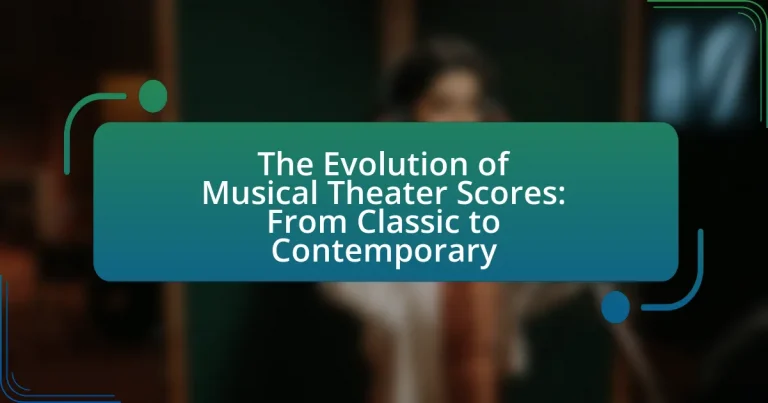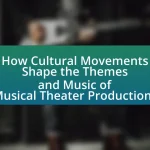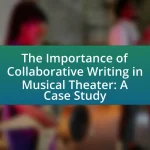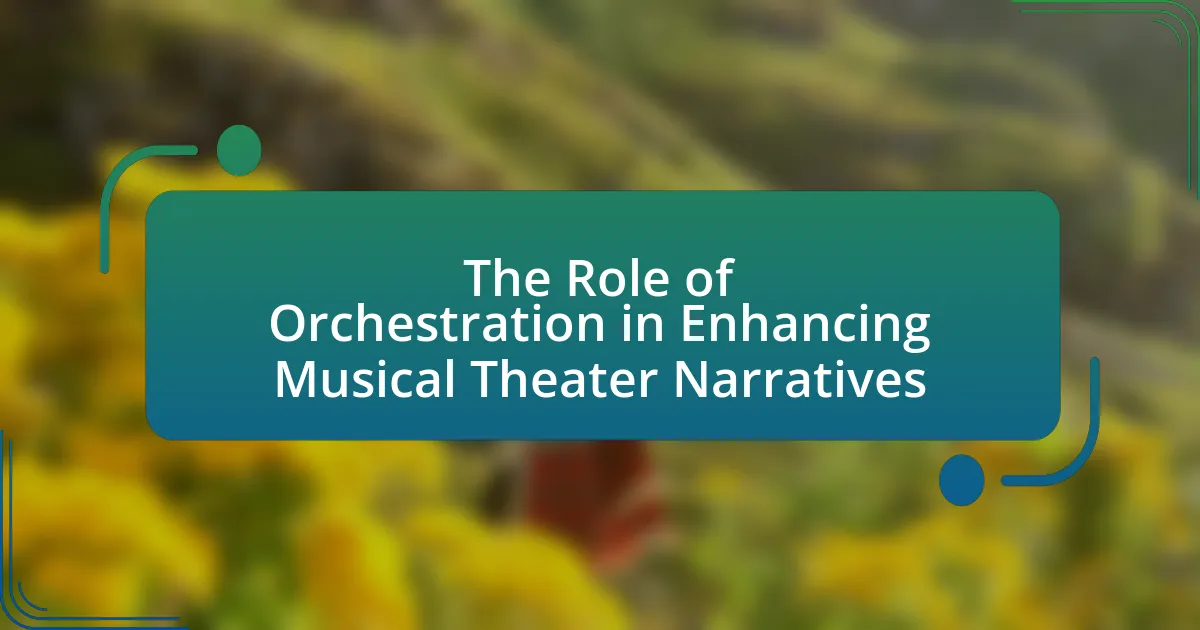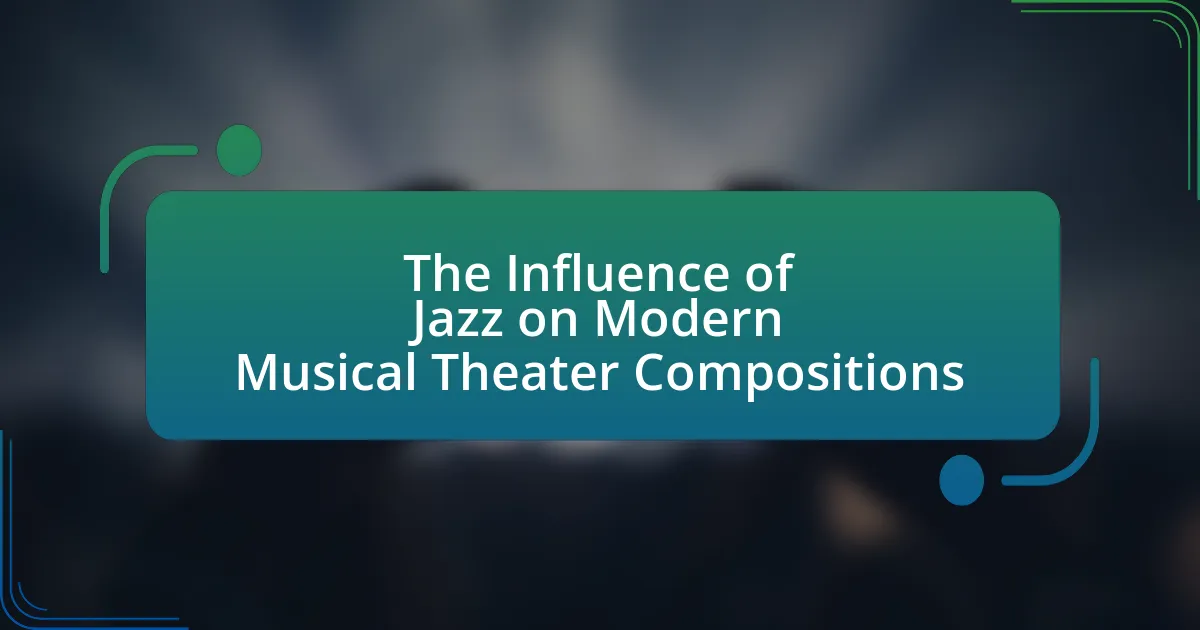The article examines the evolution of musical theater scores, tracing their development from classical structures to contemporary styles. It highlights key periods such as the Golden Age, the Rock Musical Era, and the Contemporary Era, emphasizing how musical influences and storytelling techniques have transformed over time. The discussion includes defining characteristics of classic scores, the impact of rock and pop influences, and the significance of technological advancements in modern compositions. Additionally, it explores how contemporary scores reflect current societal themes and the implications for storytelling and audience engagement in musical theater.
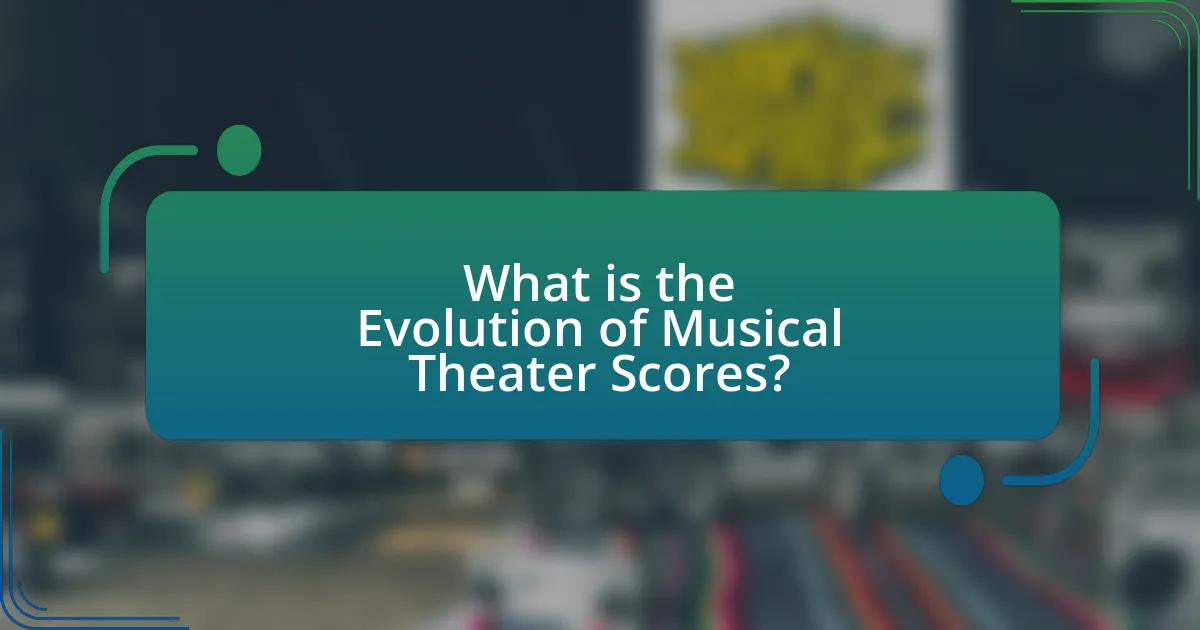
What is the Evolution of Musical Theater Scores?
The evolution of musical theater scores reflects a transition from classical structures to contemporary styles, showcasing diverse musical influences and storytelling techniques. Early musical theater, such as operettas in the 19th century, emphasized melodic lines and orchestral arrangements, with composers like Gilbert and Sullivan setting the stage for narrative-driven music. The Golden Age of Broadway, from the 1940s to the 1960s, introduced integrated scores where songs advanced the plot, exemplified by composers like Rodgers and Hammerstein.
In the late 20th century, the emergence of rock and pop influences transformed musical scores, as seen in productions like “Hair” and “Rent,” which incorporated contemporary musical styles to resonate with modern audiences. The 21st century has further diversified musical theater scores, with shows like “Hamilton” blending hip-hop, R&B, and traditional musical elements, reflecting cultural shifts and expanding the genre’s boundaries. This progression illustrates how musical theater scores have adapted to societal changes while maintaining their core function of enhancing storytelling.
How have musical theater scores changed over time?
Musical theater scores have evolved significantly over time, transitioning from traditional, structured compositions to more diverse and experimental forms. Early musical theater, exemplified by works like “Oklahoma!” in the 1940s, featured melodies that adhered to classical forms and straightforward storytelling. In contrast, contemporary scores, such as those in “Hamilton,” incorporate a blend of genres, including hip-hop, rock, and pop, reflecting broader cultural influences and appealing to diverse audiences. This shift is evidenced by the increasing complexity of musical arrangements and the integration of non-traditional storytelling techniques, which have become prominent since the late 20th century.
What are the defining characteristics of classic musical theater scores?
Classic musical theater scores are characterized by their strong melodic lines, structured forms, and integration of song and narrative. These scores often feature memorable tunes that are designed to be easily sung and remembered, reflecting the emotional arcs of the characters. Additionally, classic scores typically employ traditional musical forms such as the verse-chorus structure, which helps to establish a clear and engaging storytelling framework. The use of orchestration is also significant, with lush arrangements that enhance the emotional impact of the songs. Historical examples include the works of composers like Rodgers and Hammerstein, whose scores in shows like “Oklahoma!” and “The Sound of Music” exemplify these characteristics through their memorable melodies and cohesive storytelling.
How do contemporary musical theater scores differ from classic ones?
Contemporary musical theater scores differ from classic ones primarily in their incorporation of diverse musical styles and themes. While classic scores often relied on traditional structures and orchestration, contemporary scores frequently blend genres such as pop, rock, hip-hop, and electronic music, reflecting current cultural trends. For example, shows like “Hamilton” utilize rap and hip-hop to convey narrative and character, a stark contrast to the operatic and melodic focus of classic musicals like “Oklahoma!” or “The Sound of Music.” Additionally, contemporary scores often feature more complex character development and emotional depth, as seen in “Dear Evan Hansen,” which addresses modern issues like mental health, whereas classic scores typically adhered to simpler, more universal themes. This evolution in musical style and thematic complexity illustrates the shifting landscape of musical theater, adapting to contemporary audiences and societal changes.
Why is the evolution of musical theater scores significant?
The evolution of musical theater scores is significant because it reflects changing cultural values, artistic innovations, and audience expectations over time. As musical theater has progressed from the early 20th century to contemporary works, scores have incorporated diverse musical styles, storytelling techniques, and thematic depth, enhancing the emotional and narrative complexity of productions. For instance, the transition from the traditional operetta style of composers like Gilbert and Sullivan to the rock-infused scores of shows like “Rent” illustrates this shift. This evolution not only showcases the adaptability of the genre but also its ability to resonate with contemporary societal issues, making musical theater a relevant and dynamic form of artistic expression.
What impact has this evolution had on storytelling in musical theater?
The evolution of musical theater scores from classic to contemporary has significantly enhanced storytelling by integrating diverse musical styles and narrative techniques. This shift allows for more complex character development and emotional depth, as seen in contemporary works like “Hamilton,” which employs hip-hop to convey historical narratives and personal stories. Additionally, the use of varied musical genres enables a broader audience connection, making themes more relatable and engaging. This transformation reflects a trend where music not only supports but drives the narrative, creating a more immersive experience for the audience.
How has audience perception of musical theater changed with score evolution?
Audience perception of musical theater has evolved significantly alongside the evolution of scores, shifting from a focus on traditional melodies and orchestration to a broader appreciation for diverse musical styles and innovative compositions. Historically, audiences valued the classical structures and familiar tunes of early musicals, which often adhered to specific genres and formats. As scores began to incorporate elements from rock, pop, and hip-hop, such as in “Rent” and “Hamilton,” audiences responded positively, embracing the new sounds and storytelling techniques that reflected contemporary culture. This shift is evidenced by the increasing popularity of musicals that challenge conventional norms, leading to a more inclusive and varied audience base that appreciates the artistic diversity in modern musical theater.
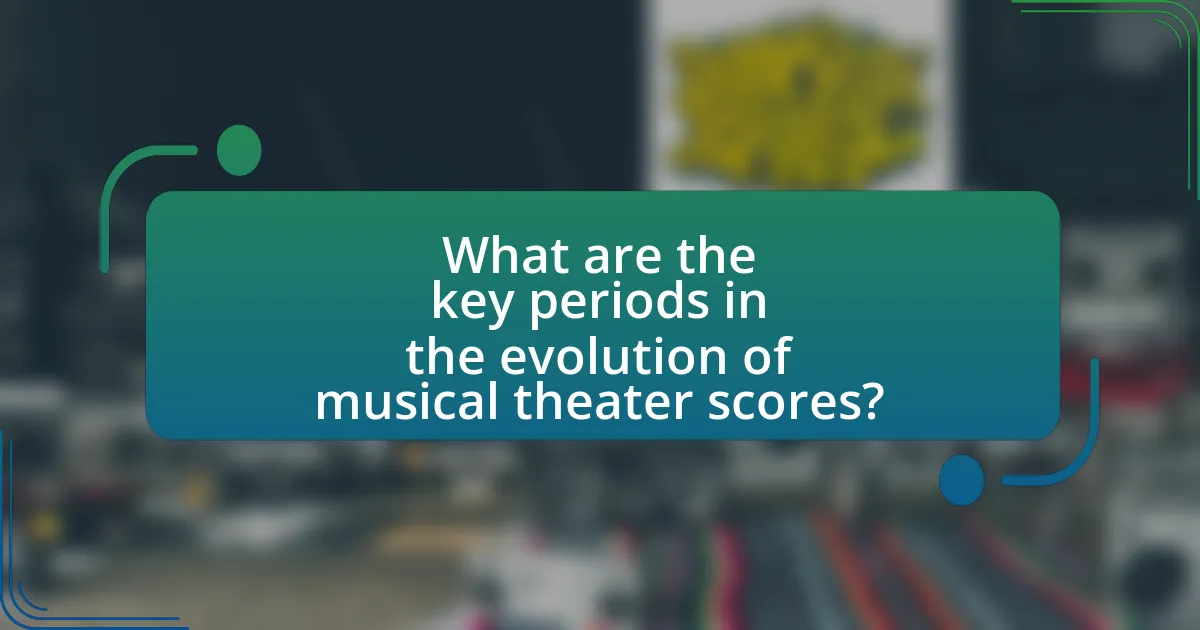
What are the key periods in the evolution of musical theater scores?
The key periods in the evolution of musical theater scores include the Golden Age (1940s-1960s), the Rock Musical Era (1960s-1970s), the Concept Musical Phase (1970s-1980s), and the Contemporary Era (1990s-present). The Golden Age is characterized by the emergence of integrated scores with strong melodies and lyrics, exemplified by works like “Oklahoma!” and “South Pacific.” The Rock Musical Era introduced rock music influences, seen in productions like “Hair” and “Jesus Christ Superstar.” The Concept Musical Phase focused on thematic storytelling, with shows like “A Chorus Line” and “Sweeney Todd” emphasizing narrative over traditional structure. The Contemporary Era showcases diverse styles and influences, including hip-hop and pop, as seen in “Hamilton” and “Dear Evan Hansen.” Each period reflects significant shifts in musical styles and storytelling techniques, marking the evolution of musical theater scores.
What defines the Golden Age of Musical Theater?
The Golden Age of Musical Theater is defined by the period from the 1940s to the 1960s, characterized by the emergence of integrated musicals where songs and dances were essential to the narrative. This era produced iconic works such as “Oklahoma!” (1943) and “West Side Story” (1957), which showcased a seamless blend of storytelling and musical composition. The integration of music, lyrics, and dialogue during this time set a standard for future productions, emphasizing character development and emotional depth through song. The success of these musicals is evidenced by their lasting impact on the genre, influencing contemporary musical theater and establishing a foundation for modern storytelling techniques.
Which composers were pivotal during the Golden Age?
The composers pivotal during the Golden Age of Musical Theater include Richard Rodgers, Oscar Hammerstein II, and Leonard Bernstein. Richard Rodgers and Oscar Hammerstein II collaborated on landmark productions such as “Oklahoma!” and “The Sound of Music,” which introduced innovative storytelling through music. Leonard Bernstein’s work on “West Side Story” combined classical music elements with contemporary themes, further shaping the genre. These composers significantly influenced the structure and style of musical theater, establishing a foundation that continues to impact the genre today.
What themes and styles were prevalent in scores from this period?
Scores from this period predominantly featured themes of love, social issues, and personal struggle, often expressed through a blend of traditional musical styles and contemporary influences. The integration of diverse musical genres, such as rock, pop, and jazz, became common, reflecting the evolving cultural landscape. For instance, the use of character-driven storytelling in songs allowed for deeper emotional connections, as seen in productions like “Rent” and “Hamilton,” which addressed themes of identity and resilience. This shift towards more relatable and modern themes marked a significant evolution in musical theater, aligning with societal changes and audience expectations.
How did the Rock and Pop influences shape musical theater scores?
Rock and Pop influences significantly shaped musical theater scores by introducing contemporary rhythms, vocal styles, and thematic content that resonate with modern audiences. The integration of electric guitars, synthesizers, and a focus on catchy melodies transformed traditional orchestration, making scores more accessible and relatable. For instance, the musical “Hair,” which debuted in 1967, utilized rock music to address social issues, reflecting the counterculture of the time. Additionally, shows like “Rent” incorporated pop and rock elements to convey emotional depth and urgency, appealing to a younger demographic. This evolution in musical theater scores demonstrates how the infusion of popular music genres has broadened the expressive range and cultural relevance of the medium.
What notable musicals emerged from this influence?
Notable musicals that emerged from the evolution of musical theater scores include “Hamilton,” “Rent,” and “Wicked.” “Hamilton,” created by Lin-Manuel Miranda, revolutionized the genre by integrating hip-hop and R&B into its score, reflecting contemporary cultural influences. “Rent,” by Jonathan Larson, introduced rock music elements and addressed social issues, marking a significant shift in musical storytelling. “Wicked,” with music and lyrics by Stephen Schwartz, blended pop and traditional musical styles, showcasing the evolution towards more diverse musical influences. These musicals exemplify the transition from classic to contemporary scores in musical theater.
How did these influences alter the musical structure and composition?
Influences such as cultural shifts, technological advancements, and changing audience expectations significantly altered the musical structure and composition of musical theater. These factors led to the incorporation of diverse musical styles, resulting in more complex harmonies and rhythms, as seen in the transition from traditional show tunes to contemporary pop and rock influences. For example, the integration of rock elements in shows like “Rent” introduced a more dynamic and varied musical landscape, reflecting societal changes and appealing to younger audiences. Additionally, advancements in sound technology allowed for richer orchestrations and innovative sound designs, further transforming the compositional approach in modern musicals.
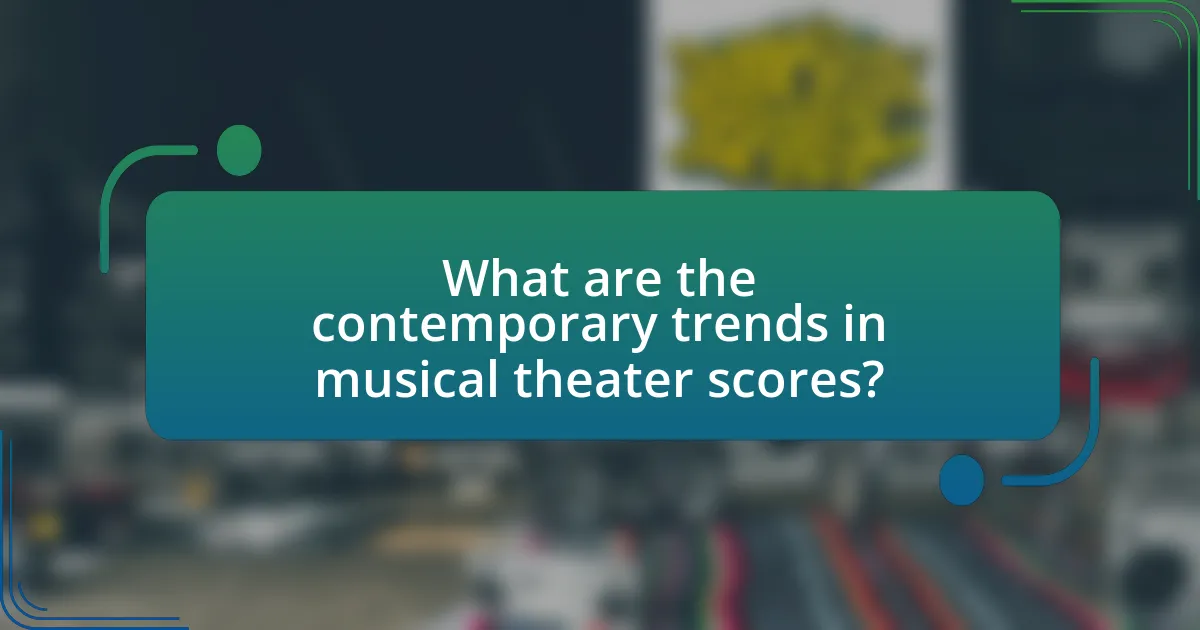
What are the contemporary trends in musical theater scores?
Contemporary trends in musical theater scores include the integration of diverse musical styles, the use of contemporary pop and rock influences, and a focus on character-driven storytelling through music. These trends reflect the evolving tastes of audiences and the desire for more relatable and modern narratives. For instance, shows like “Hamilton” utilize hip-hop and R&B to convey historical themes, while “Dear Evan Hansen” incorporates pop elements to address contemporary issues such as mental health and social media. This blending of genres not only broadens the appeal of musical theater but also allows for innovative storytelling techniques that resonate with today’s audiences.
How are modern composers redefining musical theater scores?
Modern composers are redefining musical theater scores by incorporating diverse musical styles, innovative storytelling techniques, and technology-driven elements. For instance, composers like Lin-Manuel Miranda blend hip-hop with traditional musical theater, as seen in “Hamilton,” which uses rap to convey character development and historical narrative. Additionally, contemporary works often feature non-linear storytelling and character-driven songs that reflect modern themes, such as mental health and identity, exemplified in shows like “Dear Evan Hansen.” This evolution is supported by the increasing use of digital tools in composition and production, allowing for richer soundscapes and more complex arrangements, as demonstrated in “The Band’s Visit,” which integrates Middle Eastern musical influences.
What innovative techniques are being used in contemporary scores?
Contemporary scores in musical theater utilize innovative techniques such as blending genres, incorporating technology, and employing non-traditional song structures. For instance, the fusion of pop, rock, and hip-hop elements has become prevalent, as seen in shows like “Hamilton,” which integrates rap to convey narrative and character development. Additionally, the use of digital soundscapes and electronic instrumentation enhances the auditory experience, allowing for a more immersive atmosphere. Non-linear storytelling through fragmented song forms, as exemplified in “Dear Evan Hansen,” challenges traditional musical formats and engages audiences in new ways. These techniques reflect a shift towards more diverse and modern expressions in musical theater composition.
How do contemporary scores reflect current societal themes?
Contemporary scores reflect current societal themes by incorporating diverse narratives, addressing social issues, and utilizing modern musical styles that resonate with today’s audiences. For instance, shows like “Hamilton” blend hip-hop with historical storytelling, highlighting themes of immigration and racial identity, which are prevalent in contemporary discourse. Additionally, productions such as “Dear Evan Hansen” tackle mental health and the impact of social media, reflecting the challenges faced by younger generations. These examples demonstrate how contemporary musical theater scores serve as a mirror to society, engaging with relevant topics and fostering dialogue among audiences.
What role does technology play in the creation of modern musical theater scores?
Technology plays a crucial role in the creation of modern musical theater scores by enabling composers to utilize advanced software for composition, arrangement, and orchestration. Digital audio workstations (DAWs) allow for intricate layering of sounds, real-time editing, and the integration of virtual instruments, which enhances the creative process. For instance, software like Logic Pro and Sibelius provides tools for composers to experiment with complex harmonies and orchestrations that were previously time-consuming or difficult to achieve. Additionally, technology facilitates collaboration among artists across different locations, allowing for remote contributions to the score. This integration of technology not only streamlines the production process but also expands the sonic possibilities available to composers, leading to innovative and diverse musical expressions in contemporary theater.
How has digital technology influenced composition and production?
Digital technology has significantly transformed composition and production in musical theater by enabling greater accessibility, collaboration, and innovation. Composers now utilize digital audio workstations (DAWs) like Ableton Live and Logic Pro, which allow for intricate layering of sounds and real-time editing, enhancing creative possibilities. Additionally, software instruments and plugins provide a vast array of sounds that were previously unavailable, allowing for more diverse musical styles and textures. The rise of online collaboration tools has also facilitated remote teamwork among composers, lyricists, and producers, breaking geographical barriers and fostering a more inclusive creative process. This shift is evidenced by the increasing number of contemporary musicals that incorporate electronic elements and hybrid genres, reflecting the influence of digital technology on the evolution of musical theater scores.
What are the implications of technology on live performances?
Technology significantly enhances live performances by improving sound quality, visual effects, and audience engagement. Advanced sound systems allow for clearer audio, enabling performers to reach larger audiences without distortion. Additionally, visual technology such as LED screens and projection mapping creates immersive environments that enhance storytelling. For instance, the use of automated lighting systems can dynamically change the mood of a scene, while digital instruments can expand the range of sounds available to musicians. Furthermore, technology facilitates real-time interaction with audiences through social media and mobile apps, allowing for a more personalized experience. These advancements have transformed live performances into multi-sensory experiences, making them more appealing and accessible to diverse audiences.
What can we learn from the evolution of musical theater scores?
The evolution of musical theater scores reveals the shifting cultural, social, and artistic values over time. For instance, early musical theater often emphasized operatic styles and complex orchestration, as seen in works like “Show Boat” (1927), which integrated serious themes with popular music. In contrast, contemporary scores, such as those in “Hamilton” (2015), utilize diverse musical genres, including hip-hop and R&B, reflecting modern societal issues and a broader audience appeal. This transition illustrates how musical theater adapts to changing tastes and the importance of inclusivity in storytelling, demonstrating the genre’s ability to resonate with contemporary audiences while maintaining its roots in emotional expression and narrative depth.
How can aspiring composers apply these lessons to their work?
Aspiring composers can apply lessons from the evolution of musical theater scores by studying the techniques and innovations of both classic and contemporary works. For instance, they can analyze how composers like Stephen Sondheim integrated complex harmonies and intricate lyrics, which transformed storytelling in musicals. Additionally, understanding the shift towards more diverse musical styles in contemporary theater, as seen in shows like “Hamilton,” allows composers to experiment with blending genres, thereby appealing to a broader audience. This approach is supported by the fact that contemporary musicals often incorporate elements from hip-hop, pop, and rock, reflecting current musical trends and societal themes. By embracing these lessons, aspiring composers can create innovative scores that resonate with modern audiences while honoring the rich history of musical theater.
What best practices can be adopted from historical and contemporary scores?
Best practices that can be adopted from historical and contemporary scores include the integration of diverse musical styles and the emphasis on character-driven storytelling. Historical scores often utilized traditional orchestration and melodic structures, while contemporary scores frequently incorporate various genres, such as pop, rock, and hip-hop, to appeal to modern audiences. For instance, the use of contemporary rhythms and harmonies in shows like “Hamilton” demonstrates how blending styles can enhance narrative engagement. Additionally, character development through song, as seen in classics like “West Side Story,” remains crucial; contemporary scores continue this practice by ensuring that each musical number advances the plot and deepens character arcs. This approach not only maintains audience interest but also fosters emotional connections, making it a vital best practice in musical theater composition.
